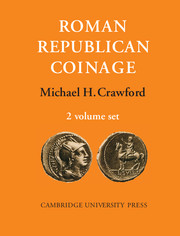Book contents
- Frontmatter
- Contents
- VOLUME I
- INTRODUCTION
- CATALOGUE
- VOLUME II
- misc-frontmatter
- 1 Technique and Technology
- 2 Weight Standards
- 3 Monetary Magistrates
- 4 Special Formulae
- 5 Administration and Control
- 6 Roman Units of Reckoning Under the Republic
- 7 Coinage and Finance
- 8 Careers of the Moneyers
- 9 Types and Legends
- 10 Art and Coinage
- Plates
- Indices
- Plate section
9 - Types and Legends
from VOLUME II
Published online by Cambridge University Press: 07 October 2011
- Frontmatter
- Contents
- VOLUME I
- INTRODUCTION
- CATALOGUE
- VOLUME II
- misc-frontmatter
- 1 Technique and Technology
- 2 Weight Standards
- 3 Monetary Magistrates
- 4 Special Formulae
- 5 Administration and Control
- 6 Roman Units of Reckoning Under the Republic
- 7 Coinage and Finance
- 8 Careers of the Moneyers
- 9 Types and Legends
- 10 Art and Coinage
- Plates
- Indices
- Plate section
Summary
The legends and types of ancient coins could be used in two ways, to indicate the authority responsible for the coins and to convey a message put out by that authority. The first piece of information must be given for a coin to be a coin at all, the second may be regarded as an optional extra. The Greeks, who took over the Lydian invention of coinage and spread it through the Greek world, on the whole concerned themselves only with indicating the authority responsible for an issue of coinage. The important coinages of classical Greece bore more or less constant types which were the badges of the issuing cities. Thus the silver tetradrachms of Athens bore the head of Athena on one side and the owl of Athena on the other. With the advent of the Hellenistic monarchs the same approach to coin types was only given a new twist. Their coins bore not only their titles, DTOAEI-loiov BacnAEws, of King Ptolemy, etc., but also their portraits, as their badge and the symbol of their sovereignty.
When the Roman Republic took over the notion of coinage, it took over also the Greek attitude towards coin types. For a century the types of the Roman coinage referred, insofar as they referred to anything at all, exclusively to Rome or her gods; these public coin types continued to be struck, although with decreasing frequency, almost to the end of the Republic. But gradually the magistrates responsible for the production of the coinage came to regard themselves as the authority responsible for it. Their names, which at first stood side by side with the name of Rome, eventually stood alone; the types which they chose were distinctive to themselves. And since they were often appointed from the ranks of the nobilitas, the coinage increasingly reflected the competitive preoccupations of the Republican oligarchy. With the beginning of the civil Wars the heads of Caesar, Antony, Octavian, Brutus and the others appeared on the coinage, in imitation of the coinage of the Hellenistic monarchs. The message conveyed by both types and legends became progressively less Republican. The late Triumviral coinage of Octavian was already Imperial in character.
A discussion of the legends and types of the Roman Republican coinage thus falls naturally into three parts: the period with public types, the development of private types and the propaganda of the Civil Wars.
- Type
- Chapter
- Information
- Roman Republican Coinage , pp. 712 - 744Publisher: Cambridge University PressPrint publication year: 1975



